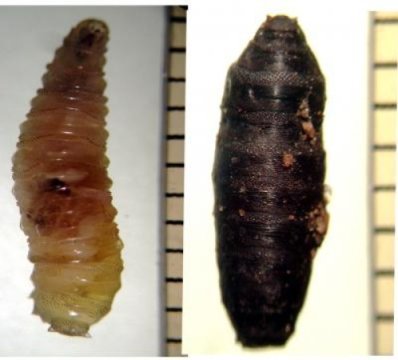After the flames from California’s forest fires died down, authorities brought in cadaver dogs to sniff through the charred remains of homes, woodland and the animals that perished in the fires, in their search for human victims. But how exactly can a hound discern between the smell of a deer carcass and that of a human remains? Researchers asked themselves the same question, and the results of their work reveal exactly how: Decomposing human bodies release a unique chemical cocktail, and experts hope the breakthrough can be useful to improve cadaver dog training or leaqd to the developmen of machines that could allow them to sniff out bodies faster than ever before.
 Image via cliparsheep
Image via cliparsheep
“The smell of death” has been puzzling researchers for more than a decade. Two papers sparked the scientific community’s efforts in 2004 — one from a research station in Tennessee titled “Body farm” that analyzed the gases released during the latter stages of decomposition, the other from Greece, that focused on the early stages of the macabre process.
The preliminary list of carbon-based compounds given off during decay that these papers put together has been added on extensively since then. However, there have been conflicting reports about which ones are emitted only by humans. And so, in 2010 the Belgian Disaster Victim Identification Team asked analytical chemist Eva Cuypers and her forensic toxicology lab at the University of Leuven in Belgium for to find the best way to train cadaver dogs to pick out human scents.
Cuypers’s graduate student Elien Rosier started by putting tissue samples and organs from six autopsied corpses in jars in a lab closet. The jars were closed using screw caps which let in some air. They had stoppered holes that allowed the team to periodically take samples of the gas build-up inside.
Other jars were set up with pig, mouse, mole, rabbit, turtle, frog, sturgeon and bird remains. Pig remains in particular have often been used in past decomposition studies because of their rare similarity to human bodies: They have the same microbes in their guts, the same percentage of body fat, and similar hair as people. But it was not clear whether the decomposition process was the same because the two species had never been studied under identical conditions.
Rosier sampled the gases released by all the jars, and compared them by species. It took a long 6 months of work, during which she identified 452 compounds that make up the rotting smell of cadavers. Her first try was with compounds containing sulfur, as they seemed to differentiate between the samples. They weren’t unique to humans however, or even present in all humans — and they weren’t very stable chemically, disappearing over time; so she looked to .
Esters are chemical compounds that are crucial in the formation of animal fats. She found that eight compounds distinguished pig and human remains from those of other animals, and five esters separated pigs from humans, PLOS ONE reports:
“The mixture of [these] compounds might be used in the future to more specifically train cadaver dogs,” Cuypers says.
“So far there [hasn’t been] any study based on monitoring human and pig carcasses under exactly the same conditions,” says Agapios Agapiou, an analytical chemist at the University of Cyprus in Nicosia who was not involved with the work. “But there are still many steps before creating a synthetic substance to train cadaver dogs.”
John Sagebiel, an analytical chemist at the University of Nevada, Reno, who was also uninvolved in the study. says relying solely on analytical chemistry to determine what cadaver dogs are sniffing out is too limited. It would be better to work with the dogs themselves to figure that out, he adds.
“I don’t think there’s one specific thing that says it’s human,” he says.
Arpad Vass — who is associated with the University of Tennessee, Knoxville, Body Farm and has compiled a list of compounds released by decomposing humans — points out that the use of specific tissues, as opposed to a whole body, and their isolation in jars means the researchers are looking at just a subset of the bacteria and other environmental factors that influence decomposition.
Cuypers says her team plans to address some of these shortfalls in future studies.
“The next step in our research is to see whether the same compounds are found in buried, full decomposing bodies in the field and to see whether dogs trained on the mixture respond more specific[ally] to human decomposing bodies.” If this cocktail passes muster, the find could pave the way for developing an electronic nose that can do what dogs do, she adds.



